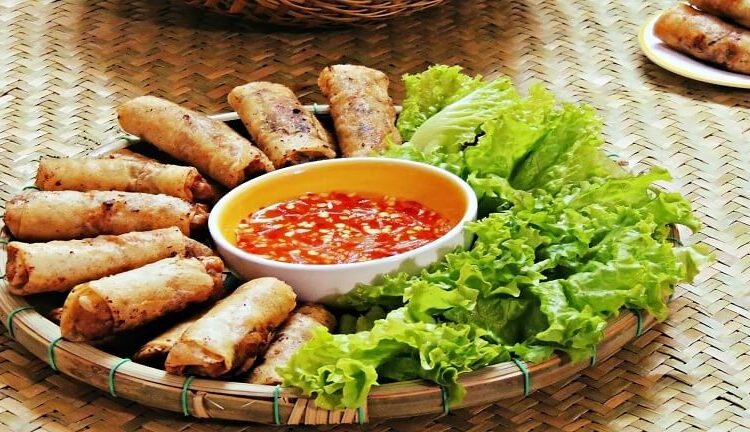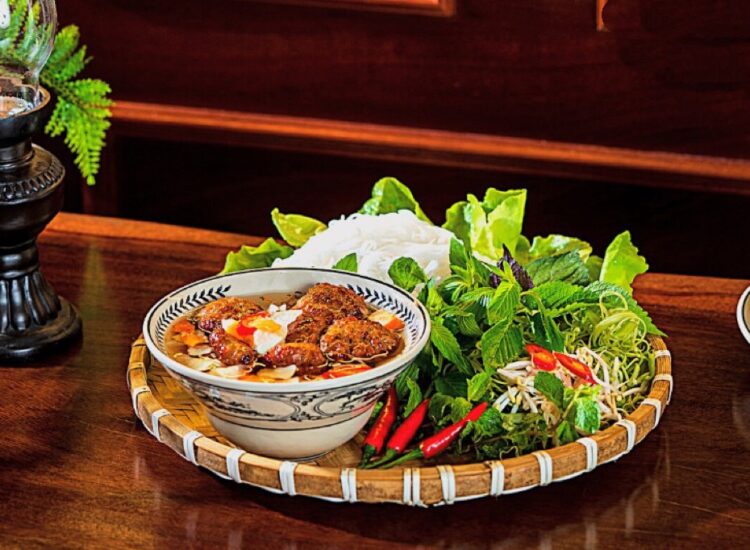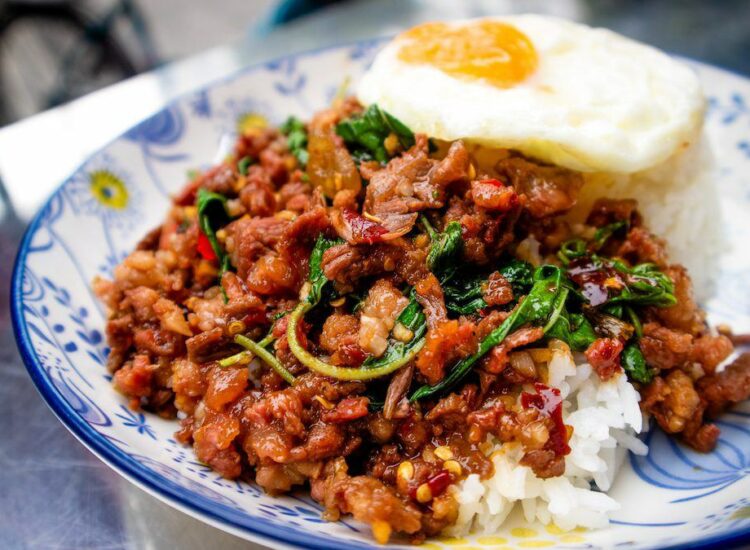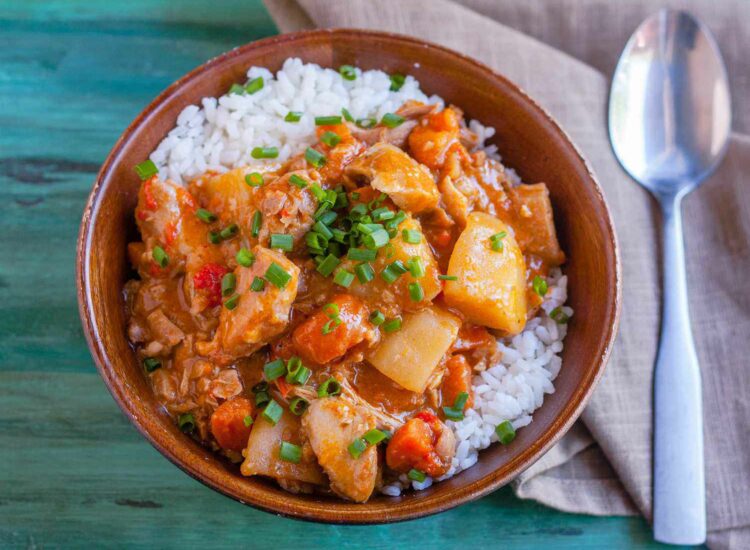Tom Kha Gai: Unveiling the Aromatic Secrets of Thai Coconut Chicken Soup
Tom Kha Gai, a name that rolls off the tongue with an exotic allure, is more than just a soup; it’s a culinary journey to the heart of Thailand. Often hailed as the gentler, creamier sibling of the fiery Tom Yum, Tom Kha Gai, or Thai Coconut Chicken Soup, is a symphony of flavors that balances creamy coconut milk with fragrant herbs and a hint of spice. This iconic Thai dish is beloved worldwide for its comforting warmth, aromatic complexity, and surprisingly easy preparation. In this comprehensive guide, we’ll delve deep into the world of Tom Kha Gai, exploring its origins, key ingredients, taste profile, variations, health benefits, and how you can easily recreate this Thai masterpiece in your own kitchen in 2025.
Toc

1. Delving into the Essence of Tom Kha Gai: Origins, Meaning, and Cultural Significance
To truly appreciate Tom Kha Gai, it’s essential to understand its roots and the cultural context that has shaped this beloved soup. Beyond its delicious taste, Tom Kha Gai carries a story of Thai culinary heritage and embodies the principles of balance and harmony that are central to Thai cuisine.
1.1 Tracing the Origins and History of Tom Kha Gai
While the exact origins are shrouded in culinary history, Tom Kha Gai is believed to have emerged from Thailand, with its earliest recorded mention dating back to around 1890 in a Thai recipe book. The initial version, known as “Tom Kha Pet,” featured duck as the protein and highlighted young galangal as a key flavoring agent. This early iteration suggests that Tom Kha may have evolved from coconut milk-based curries, adapting over time to become the distinct soup we know and love today.
The name itself offers clues to its composition and history. In Thai, “Tom” (ต้ม) means “to boil,” “Kha” (ข่า) refers to galangal, and “Gai” (ไก่) means chicken. Thus, “Tom Kha Gai” literally translates to “chicken galangal soup.” This name underscores the importance of galangal as a defining ingredient, although, as we’ll explore, coconut milk is equally crucial to its character.
Over time, chicken became the most popular protein choice, though variations using fish, seafood, and even vegetarian options with tofu are also common in Thailand. Tom Kha Gai’s global popularity soared as Thai cuisine gained international recognition, making it a staple in Thai restaurants worldwide and a favorite dish for home cooks seeking authentic Thai flavors. Its relatively mild spice level compared to Tom Yum has also contributed to its broader appeal, making it accessible to a wider range of palates.
1.2 The Meaning and Cultural Significance of Tom Kha Gai in Thai Cuisine
Tom Kha Gai is more than just a recipe; it embodies core principles of Thai cooking philosophy. Thai cuisine is renowned for its emphasis on balancing five fundamental tastes: sweet, sour, salty, bitter, and spicy. Tom Kha Gai perfectly exemplifies this balance, harmonizing creamy coconut milk (sweet and rich), tangy lime juice (sour), savory fish sauce (salty and umami), subtle chili heat (spicy), and the unique aromatic notes of galangal, lemongrass, and kaffir lime leaves (complex and fragrant).
This soup represents the art of layering flavors, where each ingredient plays a distinct yet complementary role in creating a cohesive and nuanced taste profile. The creamy coconut milk provides a luxurious base, while the herbs and spices contribute layers of aroma and complexity. The slight acidity from lime juice cuts through the richness, and a touch of chili adds a gentle warmth without overpowering the other flavors.
Culturally, Tom Kha Gai is often considered a comfort food in Thailand, enjoyed in homes and restaurants alike. Its creamy texture and fragrant aroma are deeply soothing, making it a popular choice during cooler months or when seeking a nourishing and flavorful meal. It’s also a dish that showcases the abundance of fresh, aromatic ingredients readily available in Thai cuisine, highlighting the country’s rich agricultural heritage. Serving Tom Kha Gai is often seen as an act of hospitality and care, sharing a taste of Thai warmth and culinary artistry with family and friends.
1. https://chobangkaewthai.com/a-journey-through-time-unraveling-the-history-of-massaman-curry
2. https://chobangkaewthai.com/thai-whisky-the-essence-of-sugarcane
3. https://chobangkaewthai.com/khao-soi-a-culinary-journey-into-northern-thailands-iconic-noodle-soup
2. Unpacking the Ingredients: The Building Blocks of Authentic Tom Kha Gai
The magic of Tom Kha Gai lies in its carefully selected ingredients, each contributing to the soup’s distinctive flavor and aroma. While the ingredient list may seem exotic at first glance, most components are becoming increasingly accessible in international markets, allowing home cooks worldwide to recreate this Thai classic.
2.1 The Aromatic Broth Base: Coconut Milk, Galangal, Lemongrass, and Kaffir Lime Leaves
The foundation of Tom Kha Gai’s unique character rests upon its aromatic broth, built upon a harmonious blend of key ingredients:
- Coconut Milk: Unsweetened coconut milk is the soul of Tom Kha Gai, providing its signature creamy texture and rich, slightly sweet base. Full-fat coconut milk is preferred for its richer flavor and creamier consistency, although light coconut milk can be used for a lighter version. The coconut milk not only contributes to the texture but also balances the other bolder flavors in the soup.
- Galangal (Kha): As the name suggests, galangal is indispensable to Tom Kha Gai. This rhizome, related to ginger and turmeric, offers a distinct citrusy, earthy, and slightly piney aroma that is unique and irreplaceable. Fresh galangal is ideal, but frozen or dried galangal can be used as substitutes, though with a slightly less vibrant flavor. It’s crucial not to confuse galangal with ginger; while they share a similar appearance, their flavors are distinctly different.
- Lemongrass (Takrai): Lemongrass adds a bright, citrusy, and herbaceous note to the broth. Its fragrant stalks are typically bruised and added to the soup to infuse their flavor, then removed before serving. Lemongrass contributes to the overall aromatic complexity and freshness of Tom Kha Gai.
- Kaffir Lime Leaves (Bai Makrut): Kaffir lime leaves, with their glossy, double-lobed shape, impart a uniquely fragrant citrus aroma that is essential to authentic Thai soups and curries. They contribute a distinct lime-citrusy note that is more floral and aromatic than regular lime zest. Like lemongrass, kaffir lime leaves are typically added to infuse flavor and then removed before serving.
These four ingredients—coconut milk, galangal, lemongrass, and kaffir lime leaves—form the aromatic backbone of Tom Kha Gai, creating its signature fragrance and flavor profile that distinguishes it from other soups.
2.2 Chicken and Other Flavor Enhancers: Protein, Mushrooms, Chilies, and Fish Sauce
Beyond the aromatic broth base, other key ingredients contribute to the depth of flavor and texture of Tom Kha Gai:
- Chicken (Gai): Chicken is the classic protein in Tom Kha Gai, with chicken thighs often preferred for their richer flavor and tenderness. Chicken breast can also be used, but may become drier if overcooked. The chicken absorbs the fragrant broth, adding a savory element to the soup. While chicken is traditional, variations using shrimp (Tom Kha Goong), seafood, or tofu are also popular.
- Mushrooms: Mushrooms add an earthy and umami depth to Tom Kha Gai. Straw mushrooms are commonly used in Thailand, but oyster mushrooms or other readily available varieties like button mushrooms or shiitake mushrooms can be substituted. Mushrooms complement the creamy broth and add a textural element.
- Thai Chilies (Prik Kee Nu): Thai chilies provide a touch of heat to Tom Kha Gai, balancing the richness of the coconut milk and the acidity of the lime juice. The level of chili can be adjusted to preference, ranging from mild to moderately spicy. For a milder soup, fewer chilies can be used, or they can be omitted altogether. Chili paste (Nam Prik Pao) is sometimes added for a deeper chili flavor and a hint of sweetness.
- Fish Sauce (Nam Pla): Fish sauce is a cornerstone of Thai cuisine, adding a salty and umami depth that enhances the overall flavor profile of Tom Kha Gai. It provides a savory backbone that balances the sweetness of coconut milk and the acidity of lime juice. For vegetarian versions, soy sauce or tamari can be used as substitutes, although they will impart a slightly different flavor.
- Lime Juice (Nam Manao): Fresh lime juice is added at the end of cooking to provide a crucial element of sourness and brightness. It balances the richness of the coconut milk and enhances the other aromatic flavors. Lime juice should be added just before serving to preserve its fresh, vibrant flavor.
- Cilantro (Pak Chee): Fresh cilantro leaves are typically used as a garnish, adding a fresh, herbaceous note and a pop of color to the finished soup. Cilantro complements the other aromatic ingredients and adds a final layer of flavor.
These ingredients, when combined in the right proportions and cooked with care, create the complex and harmonious flavor profile that makes Tom Kha Gai such a beloved and iconic Thai soup.
3. Savoring Tom Kha Gai: Variations, Serving Suggestions, and More
Tom Kha Gai is a versatile soup that can be enjoyed in numerous ways, with regional variations and serving suggestions that enhance its deliciousness and nutritional benefits. Whether you’re dining at a Thai restaurant or making it at home, understanding how to best enjoy Tom Kha Gai will elevate your culinary experience.

3.1 Exploring Regional Variations of Tom Kha Gai Across Thailand
While the core elements of Tom Kha Gai remain consistent, regional variations exist across Thailand, reflecting local preferences and ingredient availability. These variations showcase the adaptability of Thai cuisine and offer exciting flavor nuances to explore:
- Tom Kha Gai with Shrimp (Tom Kha Goong): In coastal regions or for seafood lovers, shrimp is a popular protein substitution for chicken. Tom Kha Goong offers a slightly sweeter and more delicate flavor profile compared to the chicken version, pairing beautifully with the creamy coconut broth.
- Tom Kha Pla (Tom Kha with Fish): Another seafood variation features fish, often using firm white fish fillets. Tom Kha Pla provides a lighter and flakier protein option, complementing the soup’s aromatic broth.
- Tom Kha with Tofu (Tom Kha Jay): For vegetarians and vegans, tofu is a common and delicious protein substitute. Firm or extra-firm tofu is typically used, absorbing the flavors of the broth and providing a satisfyingly chewy texture. Vegetarian fish sauce substitutes like soy sauce or tamari are used to maintain the umami depth.
- Spicy Tom Kha (Tom Kha Phet): While Tom Kha Gai is generally milder than Tom Yum, some regional variations incorporate more chilies or chili paste for a spicier kick. This caters to those who prefer a more intense heat level in their soup.
- Tom Kha with Roasted Chilies (Tom Kha Pao): Some versions feature roasted chilies, which add a smoky depth and complexity to the soup’s flavor profile, alongside the usual chili heat.
Exploring these regional variations allows for a deeper appreciation of the versatility of Tom Kha Gai and the diverse culinary landscape of Thailand.
3.2 Serving Suggestions, Pairings, and Health Benefits of Tom Kha Gai
Tom Kha Gai is a complete and satisfying dish on its own, but can be further enhanced with thoughtful serving suggestions and pairings:
1. https://chobangkaewthai.com/penang-curry
2. https://chobangkaewthai.com/khao-soi-a-culinary-journey-into-northern-thailands-iconic-noodle-soup
3. https://chobangkaewthai.com/bun-cha-a-culinary-journey-into-vietnams-iconic-grilled-pork-and-noodles
5. https://chobangkaewthai.com/cha-yen-delicious-drinks-from-tea-leaves
-
Serving Suggestions: Tom Kha Gai is typically served hot as a starter or a light meal. It can be enjoyed on its own or with a side of steamed jasmine rice for a more substantial meal. Garnishing with fresh cilantro and a lime wedge just before serving enhances its aroma and freshness.
-
Pairings: Tom Kha Gai pairs well with other Thai dishes, creating a balanced and flavorful Thai meal. Consider serving it alongside:
- Thai curries: Green curry, red curry, or Panang curry provide contrasting flavors and textures.
- Stir-fries: Chicken with cashew nuts, Pad See Ew (stir-fried noodles), or Pad Kra Pao (Thai basil stir-fry) offer complementary savory notes.
- Grilled dishes: Grilled chicken or seafood provides a smoky contrast to the creamy soup.
- Salads: A refreshing Thai salad like Som Tum (papaya salad) or Yam Pla Duk Foo (crispy catfish salad) can balance the richness of the soup.
-
Health Benefits: Tom Kha Gai is not only delicious but also offers several health benefits:
- Nutrient-Rich: It contains essential nutrients from coconut milk, chicken, mushrooms, and herbs.
- Anti-inflammatory Properties: Ingredients like galangal, lemongrass, and kaffir lime leaves possess anti-inflammatory compounds.
- Immune-Boosting: The herbs and spices in Tom Kha Gai are rich in antioxidants and may help boost the immune system.
- Weight Management: While coconut milk is calorie-dense, Tom Kha Gai can be part of a balanced diet, especially when made with light coconut milk and lean protein. Its high protein and healthy fat content can promote satiety.
- Digestive Health: Ginger and lemongrass, often used in Tom Kha Gai variations, are known for their digestive benefits.
3.3 Bringing Tom Kha Gai to Your Home Kitchen: A Simplified Recipe
One of the joys of Tom Kha Gai is its relative ease of preparation, making it a perfect dish for home cooking. While authentic recipes may involve making your own coconut milk and grinding spice pastes from scratch, simplified versions using readily available ingredients can still deliver delicious results.
(Simplified Recipe Outline – For a full recipe, users should search online or consult a cookbook):
- Prepare Aromatics: Bruise lemongrass stalks, slice galangal, and tear kaffir lime leaves.
- Simmer Broth: Combine coconut milk, water or chicken broth, galangal, lemongrass, and kaffir lime leaves in a pot. Bring to a simmer.
- Add Protein and Mushrooms: Add chicken or tofu and mushrooms to the broth. Simmer until cooked through.
- Season and Finish: Stir in fish sauce, lime juice, and chili paste (optional). Taste and adjust seasoning.
- Garnish and Serve: Garnish with fresh cilantro and serve hot.
Making Tom Kha Gai at home allows you to control the spice level, adjust ingredients to your preference, and enjoy the fresh, aromatic flavors of this iconic Thai soup whenever you desire.
Conclusion:
Tom Kha Gai is a culinary gem that embodies the essence of Thai cuisine: a harmonious balance of flavors, aromatic complexity, and comforting warmth. From its historical roots to its diverse regional variations and health benefits, Tom Kha Gai offers a rich and rewarding culinary experience. Whether you are a seasoned Thai food enthusiast or a curious beginner, exploring the world of Tom Kha Gai is a delicious journey that will tantalize your taste buds and transport you to the vibrant flavors of Thailand in 2025 and beyond. So, why not embark on your own Tom Kha Gai adventure today? Try making it at home, order it at your favorite Thai restaurant, and discover the magic of this iconic soup for yourself!









